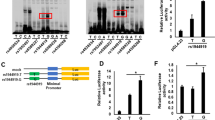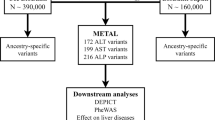Abstract
In addition to the HLA locus, six genetic risk factors for primary biliary cirrhosis (PBC) have been identified in recent genome-wide association studies (GWAS). To identify additional loci, we carried out a GWAS using 1,840 cases from the UK PBC Consortium and 5,163 UK population controls as part of the Wellcome Trust Case Control Consortium 3 (WTCCC3). We followed up 28 loci in an additional UK cohort of 620 PBC cases and 2,514 population controls. We identified 12 new susceptibility loci (at a genome-wide significance level of P < 5 × 10−8) and replicated all previously associated loci. We identified three further new loci in a meta-analysis of data from our study and previously published GWAS results. New candidate genes include STAT4, DENND1B, CD80, IL7R, CXCR5, TNFRSF1A, CLEC16A and NFKB1. This study has considerably expanded our knowledge of the genetic architecture of PBC.
This is a preview of subscription content, access via your institution
Access options
Subscribe to this journal
Receive 12 print issues and online access
$209.00 per year
only $17.42 per issue
Buy this article
- Purchase on Springer Link
- Instant access to full article PDF
Prices may be subject to local taxes which are calculated during checkout
Similar content being viewed by others
Change history
12 October 2011
In the version of this article initially published, three authors, Paul Richardson, Ikram Nasr and Richard Aspinall, were inadvertently omitted from the list of the members of the UK PBC Consortium provided in the Supplementary Note. The error has been corrected in the supplementary information file.
References
Kaplan, M.M. & Gershwin, M.E. Primary biliary cirrhosis. N. Engl. J. Med. 353, 1261–1273 (2005).
James, O.F. et al. Primary biliary cirrhosis once rare, now common in the United Kingdom? Hepatology 30, 390–394 (1999).
Jones, D.E., Watt, F.E., Metcalf, J.V., Bassendine, M.F. & James, O.F. Familial primary biliary cirrhosis reassessed: a geographically-based population study. J. Hepatol. 30, 402–407 (1999).
Donaldson, P.T. et al. HLA class II alleles, genotypes, haplotypes, and amino acids in primary biliary cirrhosis: a large-scale study. Hepatology 44, 667–674 (2006).
Hirschfield, G.M. et al. Primary biliary cirrhosis associated with HLA, IL12A, and IL12RB2 variants. N. Engl. J. Med. 360, 2544–2555 (2009).
Hirschfield, G.M. et al. Variants at IRF5-TNPO3, 17q12–21 and MMEL1 are associated with primary biliary cirrhosis. Nat. Genet. 42, 655–657 (2010).
Liu, X. et al. Genome-wide meta-analyses identify three loci associated with primary biliary cirrhosis. Nat. Genet. 42, 658–660 (2010).
Barrett, J.C. et al. Genome-wide association study of ulcerative colitis identifies three new susceptibility loci, including the HNF4A region. Nat. Genet. 41, 1330–1334 (2009).
Raychaudhuri, S. et al. Identifying relationships among genomic disease regions: predicting genes at pathogenic SNP associations and rare deletions. PLoS Genet. 5, e1000534 (2009).
Dixon, A.L. et al. A genome-wide association study of global gene expression. Nat. Genet. 39, 1202–1207 (2007).
Li, Q. & Verma, I.M. NF-κB regulation in the immune system. Nat. Rev. Immunol. 2, 725–734 (2002).
Elsharkawy, A.M. et al. The NF-κB p50:p50:HDAC-1 repressor complex orchestrates transcriptional inhibition of multiple pro-inflammatory genes. J. Hepatol. 53, 519–527 (2010).
Price, A.L. et al. Principal components analysis corrects for stratification in genome-wide association studies. Nat. Genet. 38, 904–909 (2006).
Zhernakova, A., van Diemen, C.C. & Wijmenga, C. Detecting shared pathogenesis from the shared genetics of immune-related diseases. Nat. Rev. Genet. 10, 43–55 (2009).
Jones, D.E. Pathogenesis of primary biliary cirrhosis. Gut 56, 1615–1624 (2007).
Trinchieri, G. Interleukin-12 and the regulation of innate resistance and adaptive immunity. Nat. Rev. Immunol. 3, 133–146 (2003).
Mao, T.K. et al. Altered monocyte responses to defined TLR ligands in patients with primary biliary cirrhosis. Hepatology 42, 802–808 (2005).
Vermeulen, L., Berghe, W.V., Beck, I.M., De Bosscher, K. & Haegeman, G. The versatile role of MSKs in transcriptional regulation. Trends Biochem. Sci. 34, 311–318 (2009).
Tacke, F., Luedde, T. & Trautwein, C. Inflammatory pathways in liver homeostasis and liver injury. Clin. Rev. Allergy Immunol. 36, 4–12 (2009).
Kitamura, K. et al. Pathogenic roles of tumor necrosis factor receptor p55-mediated signals in dimethylnitrosamine-induced murine liver fibrosis. Lab. Invest. 82, 571–583 (2002).
Del Villar, K. & Miller, C.A. Down-regulation of DENN/MADD, a TNF receptor binding protein, correlates with neuronal cell death in Alzheimer's disease brain and hippocampal neurons. Proc. Natl. Acad. Sci. USA 101, 4210–4215 (2004).
Sleiman, P.M. et al. Variants of DENND1B associated with asthma in children. N. Engl. J. Med. 362, 36–44 (2010).
Sarma, V., Wolf, F.W., Marks, R.M., Shows, T.B. & Dixit, V.M. Cloning of a novel tumor necrosis factor-alpha-inducible primary response gene that is differentially expressed in development and capillary tube-like formation in vitro. J. Immunol. 148, 3302–3312 (1992).
Purcell, S. et al. PLINK: a tool set for whole-genome association and population-based linkage analyses. Am. J. Hum. Genet. 81, 559–575 (2007).
Morris, J.A., Randall, J.C., Maller, J.B. & Barrett, J.C. Evoker: a visualization tool for genotype intensity data. Bioinformatics 26, 1786–1787 (2010).
Magi, R. & Morris, A.P. GWAMA: software for genome-wide association meta-analysis. BMC Bioinformatics 11, 288 (2010).
Browning, B.L. & Browning, S.R. A unified approach to genotype imputation and haplotype-phase inference for large data sets of trios and unrelated individuals. Am. J. Hum. Genet. 84, 210–223 (2009).
R Development Core Team. R: a language and environment for statistical computing. (R Foundation for Statistical Computing, Vienna, Austria, 2006.
Acknowledgements
The PBC sample collection was funded by the Isaac Newton Trust, the PBC Foundation and the Wellcome Trust (085925/Z/08/Z). The PBC Genetics Study is a portfolio study of the National Institute for Health Research Comprehensive Clinical Research Network (NIHR CRN, portfolio reference 5630). The WTCCC3 project is also supported by the Wellcome Trust (WT090355/A/09/Z, WT090355/B/09/Z). G.F.M. is a Clinical Research Training Fellow of the Medical Research Council (G0800460). G.F.M. is also supported by a Raymond and Beverly Sackler Studentship. C.J.H. is an NIHR Senior Research Fellow. C.A.A. is funded by the Wellcome Trust (WT91745/Z/10/Z).
We are grateful to the PBC Foundation for helping us to establish the PBC Genetics Study, for endorsing it, and for encouraging members of the Foundation to contribute samples. We thank all of the research nurses who assisted with participant recruitment in collaborating centers. We thank the staff in the NIHR CRN and Clinical Research Collaboration (CRC) Cymru for providing invaluable support. We are grateful to K. Chittock and his colleagues at Source Bioscience for their efforts. We thank O. Burren for designing the participant database and for providing information technology support. We acknowledge the Department of Twin Research and Genetic Epidemiology, King's College London for additional control genotype data, which was part-funded by a US National Institutes of Health National Eye Institute grant 1RO1EY018246 (PI, T. Young) and genotyping by the NIH Center for Inherited Disease Research (CIDR), with additional genotyping performed at the Wellcome Trust Sanger Institute. The study also received support from the NIHR comprehensive Biomedical Research Centre award to Guy's & St. Thomas' NHS Foundation Trust partnering King's College London. Finally, we thank the individuals who contributed samples used in this study.
Author information
Authors and Affiliations
Consortia
Contributions
Study concept and design: G.F.M., H.J.C., M.A.H., J.M.N., P.T.D., the WTCCC3 management committee (see Supplementary Note), L.P., D.E.J., G.J.A., R.N.S., C.A.A.
PBC Genetics Study management: G.F.M., D.B.D., S.J.D., A.W.M., E.F.W., R.N.S.
Case ascertainment and phenotyping: G.F.M., D.B.D., S.J.D., A.W.M., E.F.W., M.F.D., The UK PBC Consortium (see Supplementary Note), D.E.J., G.J.A., R.N.S.
Control sample ascertainment: The UK Blood Service Controls group (see Supplementary Note), The 1958 Birth Cohort Controls group (see Supplementary Note), C.J.H., C.A.A.
Genotyping: The WTCCC3 DNA, Genotyping and Informatics group (see Supplementary Note).
Statistical analysis: J.A.B.F., K.I.M., H.J.C., C.S.F., S.-Y.S., The WTCCC3 data analysis group (see Supplementary Note), C.A.A.
Manuscript preparation: G.F.M., J.A.B.F., K.I.M., H.J.C., D.E.J., G.J.A., R.N.S., C.A.A.
Corresponding authors
Ethics declarations
Competing interests
The authors declare no competing financial interests.
Additional information
A full list of members is provided in the Supplementary Note.
A full list of members is provided in the Supplementary Note.
Supplementary information
Supplementary Text and Figures
Supplementary Tables 1–10, Supplementary Figures 1–7 and Supplementary Note. (PDF 2421 kb)
Rights and permissions
About this article
Cite this article
Mells, G., Floyd, J., Morley, K. et al. Genome-wide association study identifies 12 new susceptibility loci for primary biliary cirrhosis. Nat Genet 43, 329–332 (2011). https://doi.org/10.1038/ng.789
Received:
Accepted:
Published:
Issue Date:
DOI: https://doi.org/10.1038/ng.789
This article is cited by
-
Pathogen-specific innate immune response patterns are distinctly affected by genetic diversity
Nature Communications (2023)
-
A regulatory variant at 19p13.3 is associated with primary biliary cholangitis risk and ARID3A expression
Nature Communications (2023)
-
Several genetic variants associated with systemic sclerosis in a Chinese Han population
Clinical Rheumatology (2023)
-
Environmental factors, medical and family history, and comorbidities associated with primary biliary cholangitis in Japan: a multicenter case–control study
Journal of Gastroenterology (2022)
-
JAK/STAT inhibitor therapy partially rescues the lipodystrophic autoimmune phenotype in Clec16a KO mice
Scientific Reports (2021)



